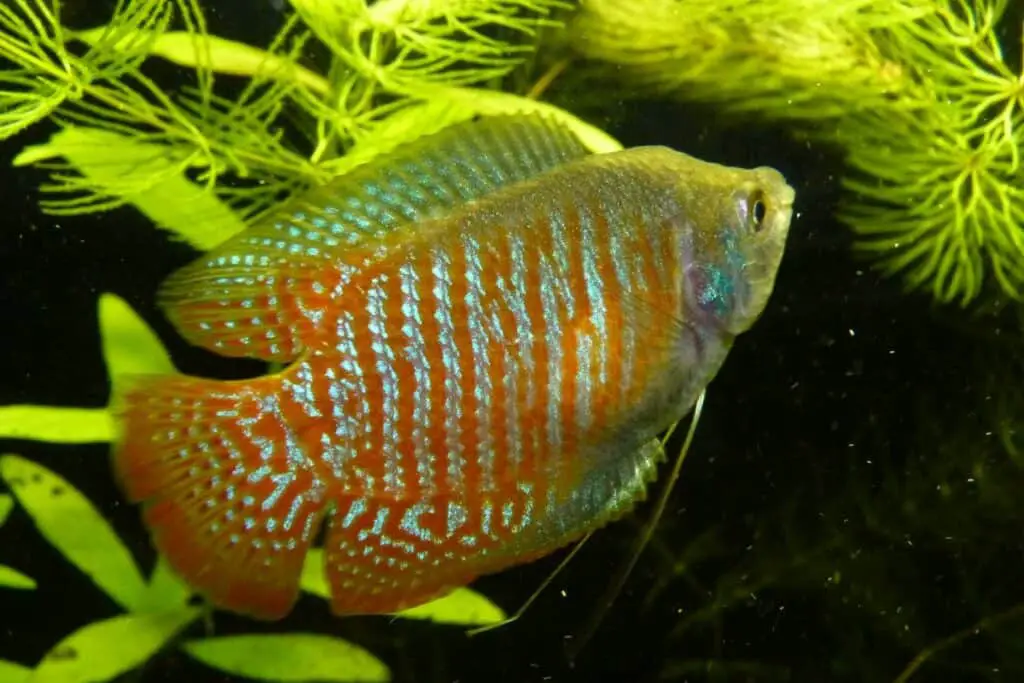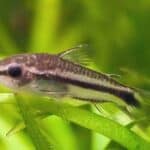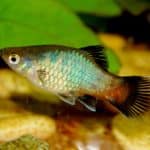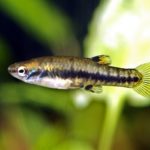So, you want to bring the majestic beauty of the Dwarf Gourami into your home? Awesome!
The Dwarf Gourami (Trichogaster lalius) is a resistant freshwater fish suitable for all aquarists, from experienced to beginners. It is adored for its shimmering, almost translucent blue colors accented by thin red or orange stripes.
Read more to ensure you keep this fish healthy and happy.

Species Summary
These Gouramis are widely distributed across Pakistan, northern India, and Bangladesh. Feral populations are found in Singapore, the USA, and Colombia. They inhabit low-flow environments such as swamps, puddles, ponds, and streams amid dense aquatic vegetation. They have already been found in waters with the most varied characteristics, from acid pH and soft hardness to alkaline water and medium hardness.
In addition, the Dwarf Gourami, similarly to the Betta, has an organ known as the Labyrinth that allows it to take in oxygen from the atmosphere. In nature, for example, if the water they are in starts to dry up or becomes very polluted, they can breathe oxygen by swallowing the air from the surface, giving them a better chance of survival.
The species usually interacts a lot with the outside of the tank and should be kept in groups with at least six fish. Fin nibblers are known; you should avoid placing them with slow fish.
So, who is best suited for a Dwarf Gourami fish? Beginners who want more color and movement in their tank.
Dwarf Gourami Care Guide
The Dwarf Gourami is a resistant and easy-to-care fish, but that does not mean its care can be done without understanding the species’ habits and behaviors.
Tank Size
When thinking about keeping gouramis together, tank size is a crucial factor.
Although these Gouramis do not reach a large size, they can be aggressive, hence the need for an aquarium with a reasonable length. Therefore, they should inhabit aquariums over 15 gallons, with dimensions starting at 24″ x 12″ x 12″.
Tank Mates
This fish species is peaceful and can coexist without problems with other animals. They can live in community aquariums with countless other fish species. However, they may be a little shy in new environments.
Avoid keeping aggressive or larger fish species in the same tank as Dwarf Gouramis, as they could injure them.
Also, this Gourami may bite fish with flashy and exuberant ends, such as Bettas and Guppies; in this case, avoid using fish with these characteristics. Barbs, Plecos, Rasboras, and Neon Tetras make great tank mates.
Same Species Tanks
The Dwarf Gourami is often kept as a single species in small aquariums.
Water Parameters
Dwarf Gouramis are highly resistant fish that can thrive in various conditions. The ideal temperature for keeping Dwarf Gouramis in an aquarium is 71 to 82 F. The ideal pH range is between 6.6 and 7.4, and hardness is between 5 and 19.
What to Put in Their Tank
As is the case with any other aquatic animal, an aquarium heater and filtering system are essential to maintaining a healthy tank for Dwarf Gourami. The filtration system must be well-sized, creating a low flow; they do not appreciate strong movement in the water.
In any case, the aquarium’s decoration is not critical to guaranteeing success in maintaining the species. Still, it is incredibly beneficial to a well-decorated and planted tank, forming hiding places and territories. They can inhabit both fine sand ponds, with driftwood, a bed of dry leaves, and densely planted aquariums; it will feel good in both environments.
Additionally, a sandy, dark substrate will further enhance your colors. You should leave a wide-open space for them to swim freely.
Densely planted aquariums are highly prized for this species. It is vital to form refuges and caves if you keep more of them together since the male harassment is quite intense with the female.
Common Diseases
The disease-resistant qualities of these fish are remarkable. If the water and tank quality are always kept in excellent condition, and good quality food is provided, your fish should not present any problems.
Food and Diet
This species is omnivorous with a tendency towards carnivores, feeding on anything of animal origin that will fit in its mouth.
In the wild, the Dwarf Gourami’s primary diet is a wide variety of foods, including rotifers, crustaceans, protozoans, worms, and small amounts of algae. Its consumption will depend on the availability of food in the natural habitat.
In an aquarium, these fish readily accept all types of food.
A combination of high-quality commercial feed and live, fresh or frozen foods such as bloodworms, brine shrimp, or daphnia will make these fish look much more vivid.
Set a regular time to feed the fish, being mindful not to overfeed them. They are fish that are always hungry.
Lifespan
Under ideal circumstances, with stable parameters and a healthy diet, this animal can live for up to six years. The most common lifespan is around four years.
Contrarily, these animals typically have shorter lifespans in nature due to their increased susceptibility to diseases, attacks from other animals, and environmental factors.
Appearance
The fish has a robust body typical of gouramis, with a slightly protruding head and a small mouth. But its main feature is its small size and striking colors. There are some variations of the fish with different coloring.
Wild fish have characteristic reddish-brown lines on both sides of their bodies. Additionally, the tips of their fins feature a light brown border. Finally, their scales are large, easily recognizable, and located very close to one another.
Size
The Golden Barb fish can grow quickly to three inches in length when given the proper care and nutrition but is typically seen at around two inches.
Behavior and Temperament
They are very active animals, occupying practically all strata of the tank; however, they prefer the middle and upper regions to stay. Be careful while feeding, as they swim fast and can feed much earlier than other fish in the aquarium.
They are shy fish when they have just been introduced to the aquarium, but over time, if the fish feel comfortable, they will start swimming and behaving naturally.
Their behavior can change if they don’t feel comfortable in the tank hidden among vegetation, rocks, and driftwood.
They are curious and interact very well with the tank and its exterior; they are intelligent and curious fish that are always on the lookout for what happens around them.
Breeding
Captive breeding is extremely simple and is carried out commercially and even accidentally in home aquariums worldwide.
It is an oviparous species, where the female lays her eggs in the bubble nest created by the male. In nature, its reproductive period follows the rhythm of floods, with the change in water chemistry being one of the main factors triggering the reproductive process.
During the reproduction phase, the male will tend to be aggressive towards the female, a behavior that will cease when the reproductive ritual begins. The two will stay under the bubble nest, with the male nudging the female with his snout and stroking the ventral area.
Spawning will occur beneath the bubble nest in the typical anabantoid hug, with the male coiling around the female and simultaneously releasing the eggs and sperm. The eggs released by the female may sink, where they will be collected by the male and placed inside the nest.
After spawning, the male will assume responsibility for guarding the nest, and the female will be severely attacked and must be removed. Hatching takes up to 36 hours, depending on the temperature. After they are swimming freely, the male can be removed. Unique spawns can generate up to 600 to 700 eggs.
Gender Differences: Male vs Female
It is apparent that there is sexual dimorphism in adult animals. Adult males are slightly larger and more colorful, and females are silvery. Males have more extended dorsal and anal fins than females.
Dwarf Gourami Fun Facts
- Prevalent species among aquarists due to its beauty, rusticity, and peaceful behavior, there are numerous varieties of colors from this species.
- It is common to find it in hot regions and stagnant waters poor in oxygen amid dense vegetation in its natural environment.
- They can breathe atmospheric oxygen through their accessory organ, known as the labyrinth. A modification forms this organ in the first-gill arch, highly vascularized and richly irrigated by blood vessels, making the air pass very close to the bloodstream, providing oxygen exchange with the blood through diffusion. The organ’s structure varies in complexity between species, tending to be more developed in specimens that inhabit an oxygen-deprived environment.
References
Baensch, H.A. and R. Riehl, 1985. Aquarien atlas. Band 2. Mergus, Verlag für Natur-und Heimtierkunde GmbH, Melle, Germany. 1216 p.
Menon, A.G.K., 1999. Checklist – freshwater fishes of India. Rec. Zool. Surv. India, Misc. Publ., Occas. Pap. No. 175, 366 p.
Zuanon, J. A. S., Carneiro, A. P. S., Nascimento, L. D. S., Silva, D. A. D., Pontes, M. D., Kanashiro, M. Y., & Salaro, A. L. (2013). Protein requirement for Trichogaster lalius, blue variety. Revista Brasileira de Zootecnia, 42, 144-147.








